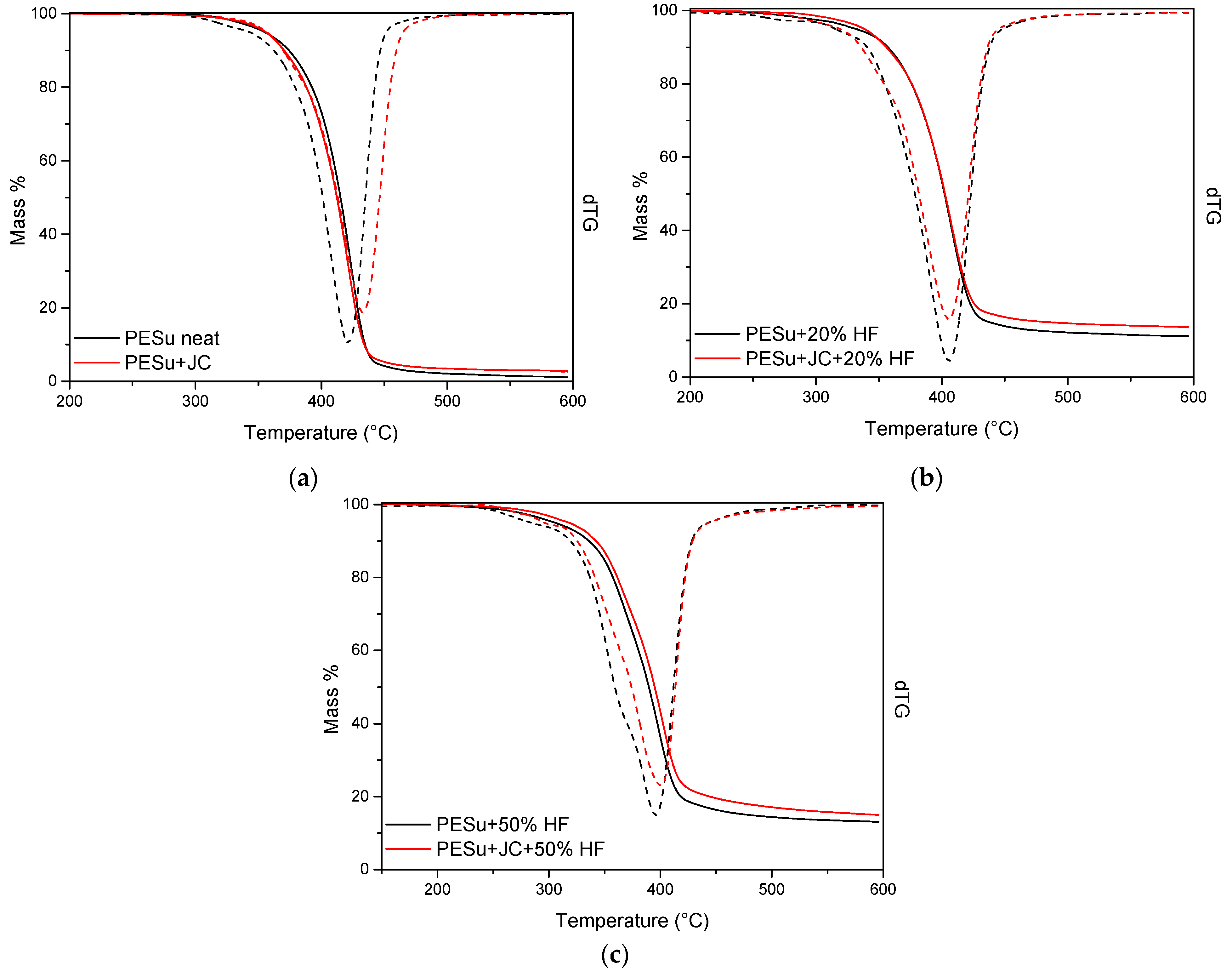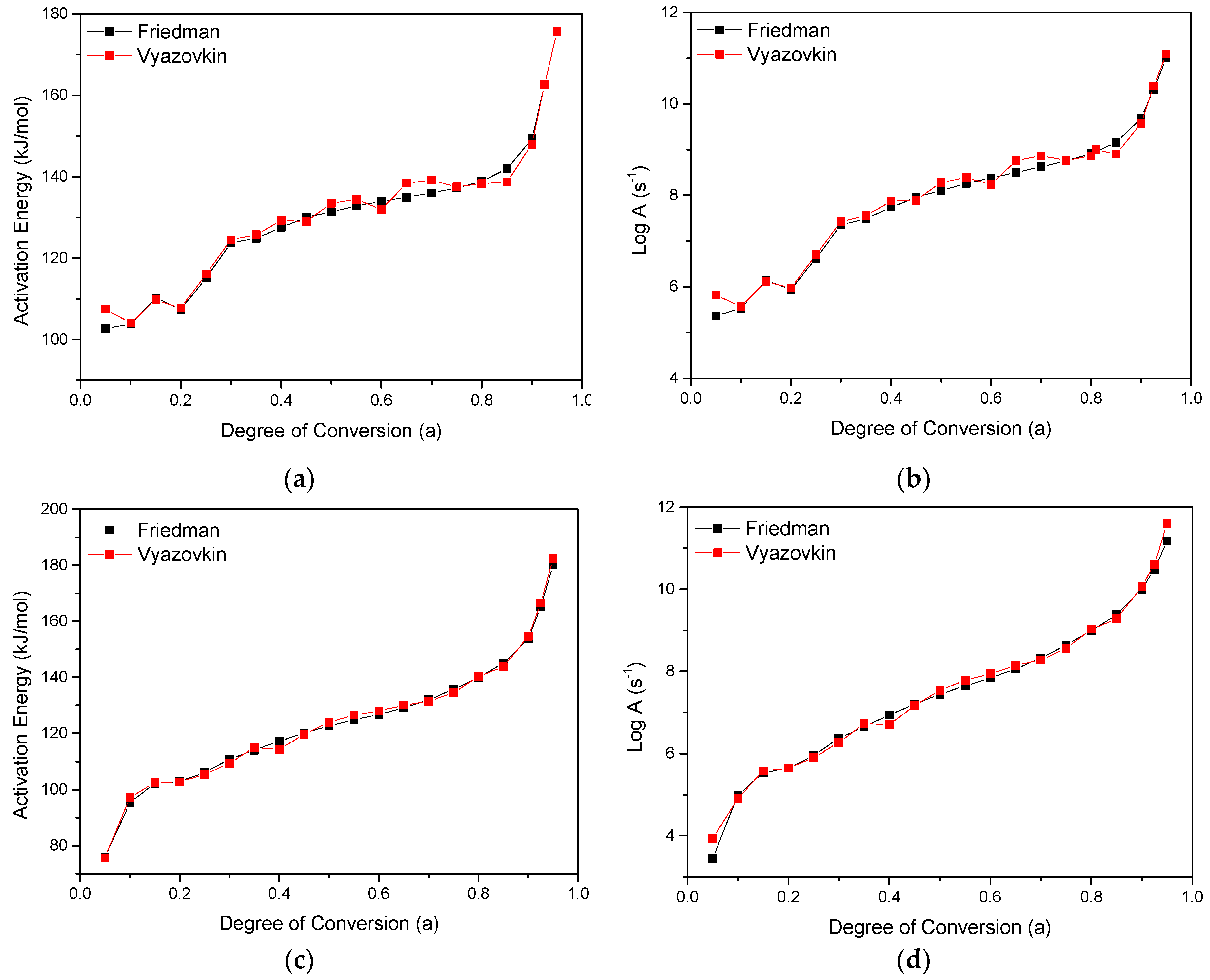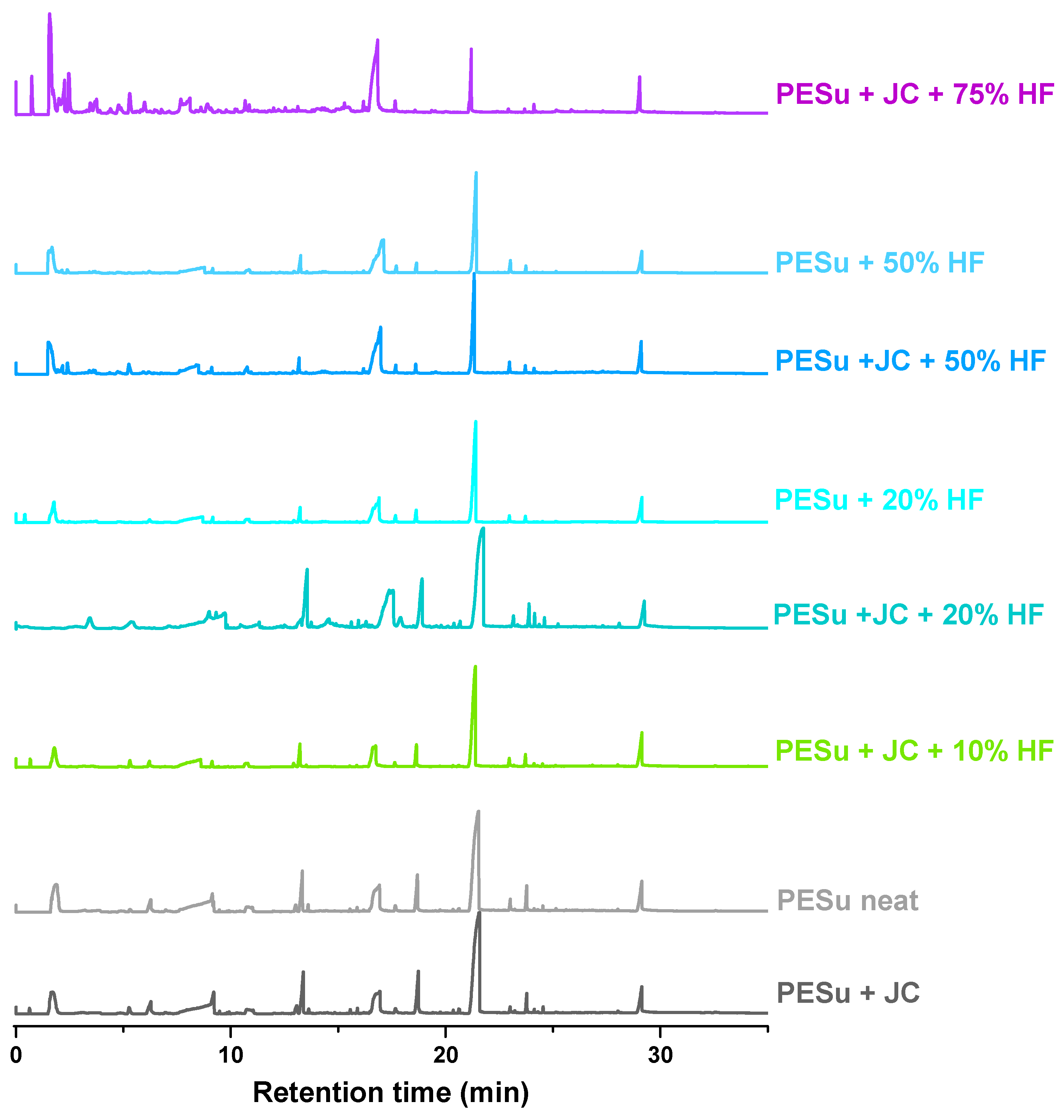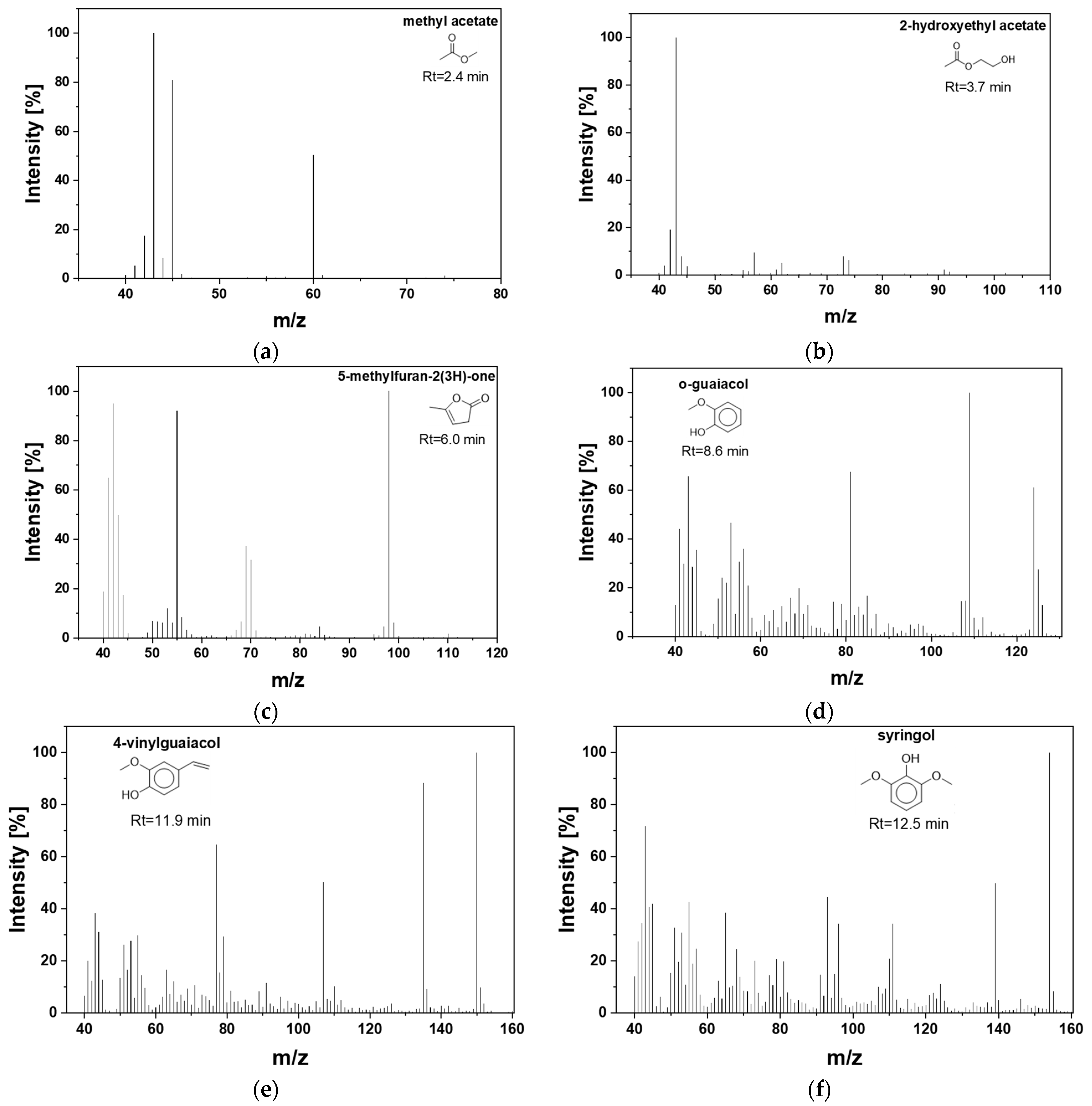Thermal Degradation Mechanism and Decomposition Kinetic Studies of Poly(Ethylene Succinate)/Hemp Fiber Composites
Abstract
:1. Introduction
2. Materials and Methods
2.1. Materials
2.2. Synthesis of Poly(ethylene succinate) (PESu) and Its Composites with Hemp Fibers
2.3. Characterization Methods
2.3.1. Thermogravimetric Analysis (TGA)
2.3.2. Pyrolysis–Gas Chromatography/Mass Spectrometry (Py–GC/MS)
3. Results
3.1. Thermogravimetric Analysis
3.2. Kinetic Analysis Based on Thermogravimetric Data—Isoconversional Methods
3.3. Pyrolysis–Gas Chromatography/Mass Spectrometry (Py–GC/MS) Study
4. Conclusions
Author Contributions
Funding
Conflicts of Interest
References
- Hoelscher, F.; Cardoso, P.B.; Candiotto, G.; Guindani, C.; Feuser, P.; Araújo, P.H.H.; Sayer, C. In Vitro Degradation and Cytotoxicity Response of Biobased Nanoparticles Prepared by Thiol-Ene Polymerization in Miniemulsion. J. Polym. Environ. 2021, 29, 3668–3678. [Google Scholar] [CrossRef]
- He, Z.; Feng, Y.; Wang, C.; Yang, J.; Tan, T.; Yang, J. Structure and Properties of New Biodegradable Elastomers Composed of Poly(Ethylene Succinate)-Based Poly(Ether Ester)s and Poly(Lactic Acid). J. Appl. Polym. Sci. 2023, 140, 1–15. [Google Scholar] [CrossRef]
- Keridou, I.; Franco, L.; del Valle, L.J.; Martínez, J.C.; Funk, L.; Turon, P.; Puiggalí, J. Hydrolytic and Enzymatic Degradation of Biobased Poly(4-Hydroxybutyrate) Films. Selective Etching of Spherulites. Polym. Degrad. Stab. 2021, 183, 109451. [Google Scholar] [CrossRef]
- Rowe, M.D.; Eyiler, E.; Walters, K.B. Hydrolytic Degradation of Bio-Based Polyesters: Effect of PH and Time. Polym. Test. 2016, 52, 192–199. [Google Scholar] [CrossRef]
- Lv, X.; Luo, F.; Zheng, L.; Niu, R.; Liu, Y.; Xie, Q.; Song, D.Q.; Zhang, Y.C.; Zhou, T.; Zhu, S. Biodegradable Poly(Butylene Succinate-Co-Butylene Furandicarboxylate): Effect of Butylene Furandicarboxylate Unit on Thermal, Mechanical, and Ultraviolet Shielding Properties, and Biodegradability. J. Appl. Polym. Sci. 2022, 139, e53122. [Google Scholar] [CrossRef]
- Burelo, M.; Gutiérrez, S.; Treviño-Quintanilla, C.D.; Cruz-Morales, J.A.; Martínez, A.; López-Morales, S. Synthesis of Biobased Hydroxyl-Terminated Oligomers by Metathesis Degradation of Industrial Rubbers SBS and PB: Tailor-Made Unsaturated Diols and Polyols. Polymers 2022, 14, 4973. [Google Scholar] [CrossRef]
- Chen, S.; Zou, R.; Li, L.; Shang, J.; Lin, S.; Lan, J. Preparation of Biobased Poly(Propylene 2,5-Furandicarboxylate) Fibers: Mechanical, Thermal and Hydrolytic Degradation Properties. J. Appl. Polym. Sci. 2021, 138. [Google Scholar] [CrossRef]
- Arif, Z.U.; Khalid, M.Y.; Sheikh, M.F.; Zolfagharian, A.; Bodaghi, M. Biopolymeric Sustainable Materials and Their Emerging Applications. J. Environ. Chem. Eng. 2022, 10, 108159. [Google Scholar] [CrossRef]
- Papadimitriou, S.A.; Papageorgiou, G.Z.; Bikiaris, D.N. Crystallization and Enzymatic Degradation of Novel Poly (e -Caprolactone-Co-Propylene Succinate) Copolymers. Eur. Polym. J. 2008, 44, 2356–2366. [Google Scholar] [CrossRef]
- Papageorgiou, D.G.; Roumeli, E.; Chrissafis, K.; Lioutas, C.; Triantafyllidis, K.; Bikiaris, D.; Boccaccini, A.R. Thermal Degradation Kinetics and Decomposition Mechanism of PBSu Nanocomposites with Silica-Nanotubes and Strontium Hydroxyapatite Nanorods. Phys. Chem. Chem. Phys. 2014, 16, 4830–4842. [Google Scholar] [CrossRef]
- Lv, X.; Haitao, L.; Zhengxiang, W.; Ruixue, N.; Yi, L.; Wei, Y.; Zheng, L. Synthesis of Biodegradable Polyester–Polyether with Enhanced Hydrophilicity, Thermal Stability, Toughness, and Degradation Rate. Polymers 2022, 14, 4895. [Google Scholar] [CrossRef] [PubMed]
- Bikiaris, R.D.; Ainali, N.M.; Christodoulou, E.; Nikolaidis, N.; Lambropoulou, D.A.; Papageorgiou, G.Z. Thermal Stability and Decomposition Mechanism of Poly(Alkylene Succinate)S. Macromol 2022, 2, 58–77. [Google Scholar] [CrossRef]
- Bikiaris, D.N.; Achilias, D.S. Synthesis of Poly(Alkylene Succinate) Biodegradable Polyesters, Part II: Mathematical Modelling of the Polycondensation Reaction. Polymer 2008, 49, 3677–3685. [Google Scholar] [CrossRef]
- Chrissafis, K.; Paraskevopoulos, K.M.; Bikiaris, D.N. Thermal Degradation Mechanism of Poly (Ethylene Succinate) and Poly (Butylene Succinate): Comparative Study. Thermochim. Acta 2005, 435, 142–150. [Google Scholar] [CrossRef]
- Bikiaris, D.; Prinos, J.; Panayiotou, C. Effect of EAA and Starch on the Thermooxidative Degradation of LDPE. Polym. Degrad. Stab. 1997, 56, 1–9. [Google Scholar] [CrossRef]
- Burgada, F.; Fages, E.; Quiles-Carrillo, L.; Lascano, D.; Ivorra-Martinez, J.; Arrieta, M.P.; Fenollar, O. Upgrading Recycled Polypropylene from Textile Wastes in Wood Plastic Composites with Short Hemp Fiber. Polymers 2021, 13, 1248. [Google Scholar] [CrossRef]
- Dolçà, C.; Fages, E.; Gonga, E.; Garcia-sanoguera, D.; Balart, R.; Quiles-carrillo, L. The Effect of Varying the Amount of Short Hemp Fibers on Mechanical and Thermal Properties of Wood–Plastic Composites from Biobased Polyethylene Processed by Injection Molding. Polymers 2022, 14, 138. [Google Scholar] [CrossRef]
- Väisänen, T.; Batello, P.; Lappalainen, R.; Tomppo, L. Modification of Hemp Fibers (Cannabis Sativa L.) for Composite Applications. Ind. Crops Prod. 2018, 111, 422–429. [Google Scholar] [CrossRef]
- Xanthopoulou, E.; Chrysafi, I.; Polychronidis, P.; Zamboulis, A.; Bikiaris, D.N. Evaluation of Eco-Friendly Hemp-Fiber-Reinforced Recycled HDPE Composites. J. Compos. Sci. 2023, 7, 138. [Google Scholar] [CrossRef]
- Marcuello, C.; Chabbert, B.; Berzin, F.; Bercu, N.B.; Molinari, M. Influence of Surface Chemistry of Fiber and Lignocellulosic Materials on Adhesion Properties with Polybutylene Succinate at Nanoscale. Materials 2023, 16, 2440. [Google Scholar] [CrossRef]
- Lostao, A.; Lim, K.S.; Pallarés, M.C.; Ptak, A.; Marcuello, C. Recent Advances in Sensing the Inter-Biomolecular Interactions at the Nanoscale—A Comprehensive Review of AFM-Based Force Spectroscopy. Int. J. Biol. Macromol. 2023, 238, 124089. [Google Scholar] [CrossRef] [PubMed]
- Dolza, C.; Gonga, E.; Fages, E.; Tejada-Oliveros, R.; Balart, R.; Quiles-Carrillo, L. Green Composites from Partially Bio-Based Poly(Butylene Succinate-Co-Adipate)-PBSA and Short Hemp Fibers with Itaconic Acid-Derived Compatibilizers and Plasticizers. Polymers 2022, 14, 1968. [Google Scholar] [CrossRef] [PubMed]
- Tanasă, F.; Zănoagă, M.; Teacă, C.A.; Nechifor, M.; Shahzad, A. Modified Hemp Fibers Intended for Fiber-Reinforced Polymer Composites Used in Structural Applications—A Review. I. Methods of Modification. Polym. Compos. 2020, 41, 5–31. [Google Scholar] [CrossRef]
- Ashori, A. Wood-Plastic Composites as Promising Green-Composites for Automotive Industries! Bioresour. Technol. 2008, 99, 4661–4667. [Google Scholar] [CrossRef]
- Manaia, J.P.; Manaia, A.T.; Rodriges, L. Industrial Hemp Fibers: An Overview. Fibers 2019, 7, 106. [Google Scholar] [CrossRef]
- Scarponi, C.; Messano, M. Comparative Evaluation between E-Glass and Hemp Fiber Composites Application in Rotorcraft Interiors. Compos. B Eng. 2015, 69, 542–549. [Google Scholar] [CrossRef]
- Sathish, T.; Palani, K.; Natrayan, L.; Merneedi, A.; de Poures, M.V.; Singaravelu, D.K. Synthesis and Characterization of Polypropylene/Ramie Fiber with Hemp Fiber and Coir Fiber Natural Biopolymer Composite for Biomedical Application. Int. J. Polym. Sci. 2021, 2021, 2462873. [Google Scholar] [CrossRef]
- Ticoalu, A.; Aravinthan, T.; Cardona, F. A Review of Current Development in Natural Fiber Composites in Automotive Applications. Appl. Mech. Mater. 2010, 564, 3–7. [Google Scholar] [CrossRef]
- Awwad, E.; Mabsout, M.; Hamad, B.; Farran, M.T.; Khatib, H. Studies on Fiber-Reinforced Concrete Using Industrial Hemp Fibers. Constr. Build. Mater. 2012, 35, 710–717. [Google Scholar] [CrossRef]
- Abu-Saleem, M.; Zhuge, Y.; Hassanli, R.; Ellis, M.; Rahman, M.; Levett, P. Evaluation of Concrete Performance with Different Types of Recycled Plastic Waste for Kerb Application. Constr. Build. Mater. 2021, 293, 123477. [Google Scholar] [CrossRef]
- Tran Le, A.D.; Maalouf, C.; Mai, T.H.; Wurtz, E.; Collet, F. Transient Hygrothermal Behaviour of a Hemp Concrete Building Envelope. Energy Build. 2010, 42, 1797–1806. [Google Scholar] [CrossRef]
- Shahzad, A. Hemp Fiber and Its Composites—A Review. J. Compos. Mater. 2012, 46, 973–986. [Google Scholar] [CrossRef]
- Fang, H.; Zhang, Y.; Deng, J.; Rodrigue, D. Effect of Fiber Treatment on the Water Absorption and Mechanical Properties of Hemp Fiber/Polyethylene Composites. J. Appl. Polym. Sci. 2013, 127, 942–949. [Google Scholar] [CrossRef]
- Panaitescu, D.M.; Fierascu, R.C.; Gabor, A.R.; Nicolae, C.A. Effect of Hemp Fiber Length on the Mechanical and Thermal Properties of Polypropylene/SEBS/Hemp Fiber Composites. J. Mater. Res. Technol. 2020, 9, 10768–10781. [Google Scholar] [CrossRef]
- Zhao, J.; Wang, X.; Zhou, W.; Zhi, E.; Zhang, W.; Ji, J. Graphene-Reinforced Biodegradable Poly(Ethylene Succinate) Nanocomposites Prepared by In Situ Polymerization. J. Appl. Polym. Sci. 2013, 130, 3212–3220. [Google Scholar] [CrossRef]
- Rafiqah, S.A.; Khalina, A.; Harmaen, A.S.; Tawakkal, I.A.; Zaman, K.; Asim, M.; Nurrazi, M.N.; Lee, C.H. A Review on Properties and Application of Bio-based Poly(Butylene Succinate). Polymers 2021, 13, 1436. [Google Scholar] [CrossRef]
- Bikiaris, D.N.; Chrissafis, K.; Paraskevopoulos, K.M.; Triantafyllidis, K.S.; Antonakou, E.V. Investigation of Thermal Degradation Mechanism of an Aliphatic Polyester Using Pyrolysis-Gas Chromatography-Mass Spectrometry and a Kinetic Study of the Effect of the Amount of Polymerisation Catalyst. Polym. Degrad. Stab. 2007, 92, 525–536. [Google Scholar] [CrossRef]
- Chrissafis, K.; Paraskevopoulos, K.M.; Bikiaris, D.N. Effect of Molecular Weight on Thermal Degradation Mechanism of the Biodegradable Polyester Poly(Ethylene Succinate). Thermochim. Acta 2006, 440, 166–175. [Google Scholar] [CrossRef]
- Klonos, P.A.; Papadopoulos, L.; Kasimatis, M.; Iatrou, H.; Kyritsis, A.; Bikiaris, D.N. Synthesis, Crystallization, Structure Memory Effects, and Molecular Dynamics of Biobased and Renewable Poly (n-Alkylene Succinate)s with n from 2 to 10. Macromolecules 2021, 54, 1106–1119. [Google Scholar] [CrossRef]
- Asimakidou, T.; Chrissafis, K. Thermal Behavior and Pyrolysis Kinetics of Olive Stone Residue. J. Therm. Anal. Calorim. 2022, 147, 9045–9054. [Google Scholar] [CrossRef]
- Hamadache, H.; Djidjelli, H.; Boukerrou, A.; Kaci, M.; José Antonio, J.R.; Martín-Martínez, J.M. Different Compatibility Approaches to Improve the Thermal and Mechanical Properties of EVA/Starch Composites. Polym. Compos. 2019, 40, 3242–3253. [Google Scholar] [CrossRef]
- Eszer, N.H.; Ishak, Z.A.M. Effect of Compatibilizer on Morphological, Thermal and Mechanical Properties of Starch-Grafted-Polypropylene/Kenaf Fibers Composites. IOP Conf. Ser. Mater. Sci. Eng. 2018, 368, 012017. [Google Scholar] [CrossRef]
- Zoukrami, F.; Haddaoui, N.; Sclavons, M.; Devaux, J.; Vanzeveren, C. Rheological Properties and Thermal Stability of Compatibilized Polypropylene/Untreated Silica Composites Prepared by Water Injection Extrusion Process. Polym. Bull. 2018, 75, 5551–5566. [Google Scholar] [CrossRef]
- Kim, H.S.; Kim, S.; Kim, H.J.; Yang, H.S. Thermal Properties of Bio-Flour-Filled Polyolefin Composites with Different Compatibilizing Agent Type and Content. Thermochim. Acta 2006, 451, 181–188. [Google Scholar] [CrossRef]
- Tsanaktsis, V.; Vouvoudi, E.; Papageorgiou, G.Z.; Papageorgiou, D.G.; Chrissafis, K.; Bikiaris, D.N. Thermal Degradation Kinetics and Decomposition Mechanism of Polyesters Based on 2,5-Furandicarboxylic Acid and Low Molecular Weight Aliphatic Diols. J. Anal. Appl. Pyrolysis 2015, 112, 369–378. [Google Scholar] [CrossRef]
- Vyazovkin, S.; Burnham, A.K.; Criado, J.M.; Pérez-maqueda, L.A.; Popescu, C.; Sbirrazzuoli, N. Thermochimica Acta ICTAC Kinetics Committee Recommendations for Performing Kinetic Computations on Thermal Analysis Data. Thermochim. Acta 2011, 520, 1–19. [Google Scholar] [CrossRef]
- Peterson, J.D.; Vyazovkin, S.; Wight, C.A. Kinetic Study of Stabilizing Effect of Oxygen on Thermal Degradation of Poly(Methyl Methacrylate). J. Phys. Chem. B 1999, 103, 8087–8092. [Google Scholar] [CrossRef]
- Chrissafis, K. Detail Kinetic Analysis of the Thermal Decomposition of PLA with Oxidized Multi-Walled Carbon Nanotubes. Thermochim. Acta 2010, 511, 163–167. [Google Scholar] [CrossRef]
- Vyazovkin, S. Modification of the Integral Isoconversional Method to Account for Variation in the Activation Energy. J. Comput. Chem. 2001, 22, 178–183. [Google Scholar] [CrossRef]
- Vyazovkin, S. Evaluation of Activation Energy of Thermally Stimulated Solid-State Reactions under Arbitrary Variation of Temperature. J. Comput. Chem. 1997, 18, 393–402. [Google Scholar] [CrossRef]
- Levchik, S.V.; Weil, E.D. A Review on Thermal Decomposition and Combustion of Thermoplastic Polyesters. Polym. Adv. Technol. 2004, 15, 691–700. [Google Scholar] [CrossRef]
- Nguyen, S.; Yu, G.; Marchessault, R.H. Thermal Degradation of Poly(3-Hydroxyalkanoates): Preparation of Well-Defined Oligomers. Biomacromolecules 2002, 3, 219–224. [Google Scholar] [CrossRef] [PubMed]
- Atkinson, J.L.; Vyazovkin, S. Thermal Properties and Degradation Behavior of Linear and Branched Poly(L-Lactide)s and Poly(L-Lactide-Co-Glycolide)S. Macromol. Chem. Phys. 2012, 213, 924–936. [Google Scholar] [CrossRef]
- Terzopoulou, Z.; Tsanaktsis, V.; Nerantzaki, M.; Achilias, D.S.; Vaimakis, T.; Papageorgiou, G.Z.; Bikiaris, D.N. Thermal Degradation of Biobased Polyesters: Kinetics and Decomposition Mechanism of Polyesters from 2,5-Furandicarboxylic Acid and Long-Chain Aliphatic Diols. J. Anal. Appl. Pyrolysis 2016, 117, 162–175. [Google Scholar] [CrossRef]
- Chrissafis, K.; Paraskevopoulos, K.M.; Bikiaris, D. Thermal Degradation Kinetics and Decomposition Mechanism of Two New Aliphatic Biodegradable Polyesters Poly(Propylene Glutarate) and Poly(Propylene Suberate). Thermochim. Acta 2010, 505, 59–68. [Google Scholar] [CrossRef]
- Terzopoulou, Z.; Tsanaktsis, V.; Nerantzaki, M.; Papageorgiou, G.Z.; Bikiaris, D.N. Decomposition Mechanism of Polyesters Based on 2,5-Furandicarboxylic Acid and Aliphatic Diols with Medium and Long Chain Methylene Groups. Polym. Degrad. Stab. 2016, 132, 127–136. [Google Scholar] [CrossRef]
- Rizzarelli, P.; Carroccio, S. Thermo-Oxidative Processes in Biodegradable Poly(Butylene Succinate). Polym. Degrad. Stab. 2009, 94, 1825–1838. [Google Scholar] [CrossRef]
- Liu, M.; Thygesen, A.; Summerscales, J.; Meyer, A.S. Targeted Pre-Treatment of Hemp Bast Fibres for Optimal Performance in Biocomposite Materials: A Review. Ind. Crops Prod. 2017, 108, 660–683. [Google Scholar] [CrossRef]
- Zimniewska, M. Hemp Fibre Properties and Processing Target Textile: A Review. Materials 2022, 15, 1901. [Google Scholar] [CrossRef]










| Sample | Td1 (°C) | Td2,max (°C) | Remaining Mass % |
|---|---|---|---|
| PESu + JC | - | 433.6 | 2.7 |
| PESu + JC + 10% HF | - | 408.2 | 10.1 |
| PESu + JC + 20% HF | 299.8 | 405.5 | 13.7 |
| PESu + JC + 50% HF | 297.3 | 400.2 | 14.9 |
| PESu + JC + 75% HF | 289.9 | 357.5 | 19.8 |
| Sample | Step | Mechanism | Eα (kJ/mol) | logA (s−1) | logKcat | React. Order n | R2 |
|---|---|---|---|---|---|---|---|
| PESu | 1st | Cn | 107 | 6 | 0.3 | 0.6 | 0.99994 |
| 2nd | Cn | 170 | 10.7 | 1.2 | 2.1 | ||
| PESu + JC | 1st | Cn | 75 | 3.6 | 0.1 | 0.3 | 0.99994 |
| 2nd | Cn | 114 | 6.4 | 0.8 | 0.8 | ||
| 3rd | Cn | 172 | 10.5 | 1.9 | 3.2 | ||
| PESu + 20% HF | 1st | Cn | 102 | 5.6 | 0.01 | 0.6 | 0.99992 |
| 2nd | Cn | 180 | 12.7 | 0.4 | 3.1 | ||
| PESu + JC + 20% HF | 1st | Cn | 65 | 3.2 | 0.01 | 1.1 | 0.99994 |
| 2nd | Cn | 123 | 0.7 | 0.01 | 0.7 | ||
| 3rd | Cn | 246 | 17.6 | 0.9 | 4.2 |
| Rt (min) | Sample Name | Mw (amu) | Assigned Compound | |||||||
|---|---|---|---|---|---|---|---|---|---|---|
| PESu + JC | PESu neat | PESu + JC + 10% HF | PESu + JC + 20%HF | PESu + 20% HF | PESu + JC + 50% HF | PESu + 50% HF | PESu + JC + 75% HF | |||
| Relative Intensity (%) | ||||||||||
| 0.6 | 5.73 | - | 8.24 | 2.43 | 8.02 | n.d. | n.d. | 38.3 | 40–44 | Carbox dioxide |
| 1.7 | 21.74 | 27.46 | 19.42 | 1.28 | 20.36 | 22.95 | 25.98 | 24.79 | 72 | 2-propenoic acid |
| 2.0 | n.d. | n.d. | n.d. | n.d. | n.d. | 8.82 | 3.56 | 16.27 | 88 | 1-hydroxybutan-2-one |
| 2.4 | n.d. | n.d. | n.d. | 2.21 | n.d. | 11.32 | 3.8 | 41.08 | 74 | methyl acetate |
| 3.7 | n.d. | n.d. | n.d. | n.d. | n.d. | 4.24 | 2.01 | 15.61 | 102 | 2-hydroxyethyl acetate |
| 4.4 | n.d. | n.d. | n.d. | n.d. | n.d. | n.d. | n.d. | 6.18 | 108 | p-cresol |
| 6.0 | n.d. | n.d. | n.d. | n.d. | n.d. | n.d. | n.d. | 12.5 | 98 | 5-methylfuran-2(3H)-one |
| 6.3 | 12.3 | 12.57 | 6.03 | 1.21 | 2.98 | 2.71 | 2.32 | 3.87 | 100 | Propanoic acid, 2-hydroxyethyl ester |
| 8.6 | n.d. | n.d. | n.d. | n.d. | n.d. | n.d. | n.d. | 7.85 | 124 | 2-methoxy-phenol (o-Guaiacol) |
| 9.2 | 21.84 | 18.43 | 6.01 | 16.72 | 5.43 | 7.11 | 5.24 | 5.28 | 114 | Succinic anhydride |
| 10.7 | 4.57 | 5.36 | 3.96 | 4.36 | 3.44 | 7.32 | 3.62 | 14.23 | 143 | 4-oxo-4-(vinyloxy)butanoic acid |
| 11.9 | n.d. | n.d. | n.d. | n.d. | n.d. | n.d. | n.d. | 7.06 | 150 | 4-Vinylguaiacol |
| 12.5 | n.d. | n.d. | n.d. | n.d. | n.d. | n.d. | n.d. | 7.01 | 154 | 2,6-dimethoxy-phenol (syringol)  |
| 13.1 | 8.31 | 7.29 | 6.38 | 9.74 | 2.17 | 16.48 | 2.24 | 8.52 | 158 | 4-(allyloxy)-4-oxobutanoic acid |
| 13.3 | 41.35 | 40.92 | 23.08 | 59.08 | 14.96 | 1.58 | 17.89 | 4.27 | 160 | 4-(2-hydroxyethoxy)-4-oxobutanoic acid |
| 13.6 | 5.01 | 7.6 | 2.37 | 3.81 | 1.6 | 1.44 | n.d. | 4.11 | 160 | 4-oxo-4-(2-oxoethoxy)butanoic acid |
| 15.5 | 4.52 | 3.27 | 1.59 | 2.63 | n.d. | 1.8 | n.d. | 7.89 | 172 | Butanedioic acid, diethyl ester |
| 15.9 | 5.80 | 4.87 | 1.07 | 8.76 | 1.12 | 1.97 | 1.42 | 3.83 | 186 | 2-oxoethyl vinyl succinate |
| 16.9 | 22.59 | 27.1 | 21.4 | 38.2 | 24.66 | 46.88 | 32.84 | 74.19 | 174 | ethane-1,2-diyl dipropionate |
| 17.6 | 5.31 | 6.60 | 4.96 | 11.53 | 6.94 | 9.38 | 7.61 | 13.78 | 189 | 2-hydroxyethyl vinyl succinate |
| 18.7 | 42.02 | 37.02 | 22.28 | 49.68 | 12.27 | 10.32 | 10.4 | 4.87 | 201 | Allyl (2-hydroxyethyl) succinate |
| 20.3 | 3.92 | 3.00 | 1.79 | 5.81 | n.d. | 1.58 | n.d. | 2.7 | 258 | 2-(acryloyloxy)ethyl (2-hydroxyethyl) succinate |
| 20.6 | 5.01 | 3.44 | 2.01 | 7.81 | n.d. | 1.37 | n.d. | 2.65 | 202 | 2-(propionyloxy)ethyl 4-oxobutanoate |
| 21.5 | 100 | 100 | 100 | 100 | 100 | 100 | 100 | 65.12 | 262 | 4,4′-(ethane-1,2-diylbis(oxy))bis(4-oxobutanoic acid) |
| 23.0 | 7.11 | 23.96 | 9.12 | 13.13 | 6.7 | 12.15 | 13 | 5.8 | 289 | 4-oxo-4-(2-((4-oxo-4-(vinyloxy)butanoyl)oxy)ethoxy)butanoic acid |
| 23.7 | 20.59 | 26.4 | 12.73 | 25.19 | 6.29 | 8.97 | 7.47 | 5.96 | 288 | 2-((4-oxobutanoyl)oxy)ethyl (2-oxoethyl) succinate |
| 24.1 | 4.78 | 3.62 | 3.89 | 15.55 | n.d. | 6.17 | 1.5 | 10.59 | 312 | O,O′-(ethane-1,2-diyl) divinyl disuccinate |
| 29.1 | 27.1 | 30.7 | 34.38 | 27.85 | 24.97 | 32.67 | 22.03 | 37.68 | 333 | 2-((4-(2-hydroxyethoxy)-4-oxobutanoyl)oxy)ethyl vinyl succinate |
Disclaimer/Publisher’s Note: The statements, opinions and data contained in all publications are solely those of the individual author(s) and contributor(s) and not of MDPI and/or the editor(s). MDPI and/or the editor(s) disclaim responsibility for any injury to people or property resulting from any ideas, methods, instructions or products referred to in the content. |
© 2023 by the authors. Licensee MDPI, Basel, Switzerland. This article is an open access article distributed under the terms and conditions of the Creative Commons Attribution (CC BY) license (https://creativecommons.org/licenses/by/4.0/).
Share and Cite
Chrysafi, I.; Ainali, N.M.; Xanthopoulou, E.; Zamboulis, A.; Bikiaris, D.N. Thermal Degradation Mechanism and Decomposition Kinetic Studies of Poly(Ethylene Succinate)/Hemp Fiber Composites. J. Compos. Sci. 2023, 7, 216. https://doi.org/10.3390/jcs7060216
Chrysafi I, Ainali NM, Xanthopoulou E, Zamboulis A, Bikiaris DN. Thermal Degradation Mechanism and Decomposition Kinetic Studies of Poly(Ethylene Succinate)/Hemp Fiber Composites. Journal of Composites Science. 2023; 7(6):216. https://doi.org/10.3390/jcs7060216
Chicago/Turabian StyleChrysafi, Iouliana, Nina Maria Ainali, Eleftheria Xanthopoulou, Alexandra Zamboulis, and Dimitrios N. Bikiaris. 2023. "Thermal Degradation Mechanism and Decomposition Kinetic Studies of Poly(Ethylene Succinate)/Hemp Fiber Composites" Journal of Composites Science 7, no. 6: 216. https://doi.org/10.3390/jcs7060216
APA StyleChrysafi, I., Ainali, N. M., Xanthopoulou, E., Zamboulis, A., & Bikiaris, D. N. (2023). Thermal Degradation Mechanism and Decomposition Kinetic Studies of Poly(Ethylene Succinate)/Hemp Fiber Composites. Journal of Composites Science, 7(6), 216. https://doi.org/10.3390/jcs7060216







